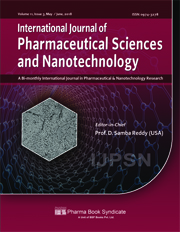Formulation and In Vivo Evaluation of Mucoadhesive Micro-spheres of Rebamipide, a Mucoprotective Drug for GIT Disorders
DOI:
https://doi.org/10.37285/ijpsn.2018.11.3.2Abstract
Rebamipide, an amino acid derivative of 2-(1H)-quinolinone, is used for mucosal protection, healing of gastroduodenal ulcers, and treatment of gastritis. The current research study aimed to develop novel gastro-retentive mucoadhesive microspheres of rebamipide using ionotropic gelation technique. Studies of micromeritic properties confirmed that microspheres were free flowing with good packability. The in vitro drug release showed the sustained release of rebamipide up to 99.23 ± 0.13% within 12 h whereas marketed product displayed the drug release of 95.15 ± 0.23% within 1 h. The release mechanism from microspheres followed the zero-order and Korsmeyer-Peppas (R2 = 0.915, 0.969), respectively. The optimized M12 formulation displayed optimum features, such as entrapment efficiency 97%, particle size 61.94 ± 0.11 µm, percentage yield 98%, swelling index 95% and mucoadhesiveness was 97%. FTIR studies revealed no major incompatibility between drug and excipients. SEM confirmed the particles were of spherical in shape. Optimized formulation (M12) were stable at 40°C ± 2°C/75% RH ± 5% RH for 6 months. In vivo studies were performed and kinetic parameters like Cmax, Tmax, AUC0-t, AUC0-∞, t1/2, and Kel were calculated. The marketed product Cmax (3.15 ± 0.05 ng/mL) was higher than optimized formulation (2.58 ± 0.03 ng/mL). The optimized formulation AUC0-t (15.25 ± 1.14 ng.hr/mL), AUC0-∞ (19.42 ± 1.24 ng.hr/mL) was significantly higher than that of marketed product AUC0-t (10.21 ± 1.26 ng.hr/mL) and AUC0-∞ (13.15 ± 0.05 ng.hr/mL). These results indicate an optimized formulation bioavailability of 2.5-fold greater than marketed product.
Downloads
Metrics
Keywords:
Rebamipide, Microspheres, Chitosan, Mucoadhesive, BioavailabilityDownloads
Published
How to Cite
Issue
Section
References
Fujioka T, Arakawa T and Shimoyama T (2003). Effects of rebamipide, a gastro-protective drug on the Helicobacter pylori status and inflammation in the gastric mucosa of patients with gastric ulcer: a randomized double-blind placebo-controlled multicentre trial. Aliment Pharmacol Ther 18: 146-152.
Hooda A, Nanda A, Jain M, Kumar V and Rathee P (2012). Optimization and evaluation of gastroretentive ranitidine HCl microspheres by using design expert software. Int J Biol Macromolecules 51: 691- 700.
Jagtap YM, Bhujbal RK, Ranade AN and Ranpise NS (2010). Effect of various polymers concentrations on physicochemical properties of floating microspheres. Ind J Pharmaceutical Sci 74(6): 512-520.
Janssen M, Timur UT and Woike N (2016). Celecoxib-loaded PEA microspheres as an auto regulatory drug-delivery system after intra-articular injection. J Controlled Rel 244: 30-40.
Jelvehgari M, Barar J, Nokhodchi A, Shadrou S, and Valizadeh H (2011). Effects of process variables on micromeritic properties and drug release of non-degradable microparticles. Advanced Pharmaceutical Bulletin 1(1): 18-26.
Kaur R, Gulati M, and Singh SK (2016). Role of symbiotics in polysaccharide assisted colon targeted microspheres of Mesalamine for the treatment of ulcerative colitis. Int J Biol Macromolecules 95: 438-450.
Kulkarni AD, Bari DB, Surana SJ and Pardeshi CV (2016). In vitro, ex vivo and in vivo performace of chitosan-based spray-dried nasal mucoadhesive microspheres of diltiazem hydrochloride. J Drug Delivery Sci Tech 31: 108-117.
Li Y, He H, Wang Q and Tang X (2016). Preparation, stability and pharmacokinetics evaluation of lipid microspheres loading a promising antitumor candidate, Timataxel. Asian J Pharmaceutical Sci 11: 771-779.
Małgorzata W, Marcin Z and Aleksandra A (2016). Tasting cetirizine-based microspheres with an electronic tongue. Sensors and Actuators B Chemical 238: 1190-1198.
Malladi M and Jukanti R (2016). Formulation development and evaluation of a novel bi-dependent clarithromycin gastro-retentive drug delivery system using box-behnken design. J Drug Delivery Sci Tech 35:134-145.
Phutane P, Shidhaye S, Lotlikar V, Ghule A, Sutar S, and Kadam V (2010). In vitro Evaluation of Novel Sustained Release Microspheres of Glipizide Prepared by the Emulsion Solvent Diffusion-Evaporation Method. J Young Pharm 2(1): 35-41.
Piacentini E, Yan M, and Giorno L (2016). Development of enzyme-loaded PVA microspheres by membrane emulsification. J Membrane Sci 524: 79-86.
Sriram N and Katakam P (2016). Formulation and Evaluation of Mucoadhesive Microspheres of Pioglitazone Hydrochloride Prepared by Ionotropic External Gelation Technique. J Encapsulation Adsorption Sci 6: 22-34.
Tao Y, Lu Y, Sun Y, Gu B, Lu W and Pan J (2009). Development of mucoadhesive microspheres of acyclovir with enhanced bioavailability. Int J Pharmaceutics 378: 30-36.
Terano A, Arakawa T and Sugiyama T (2007). Rebamipide, a gastro-protective and anti-inflammatory drug, promotes gastric ulcer healing following eradication therapy for Helicobacter pylori in a Japanese population: a randomized, double-blind, placebo-controlled trial. J Gastroenterol 42: 690-693.
Tyagi LK and Kori ML (2014). Stability Study and In-vivo Evaluation of Lornoxicam Loaded Ethyl Cellulose Microspheres. Int J Pharm Sci Drug Res 6(1): 26-30.
Velmurugan S and Ashraf Ali M (2013). Formulation and evaluation of maraviroc mucoadhesive microsheres by ionotropic gelation method. Int J Pharmacy Pharma Sci 5(4): 294-302.
Wang QS, Wang GF, Zhou J, Gao LN and Cui YL (2016). Colon targeted oral drug delivery system based on chitosan/alginate microspheres loaded with icariin in the treatment of ulcerative colitis. Int J Pharmaceutics 515(1-2): 176-185.
Zhu X, Qi X and Wu Z (2013). Preparation of multiple-unit floating-bioadhesive cooperative mini tablets for improving the oral bioavailability of famotidine in rats. Drug Delivery 4: 1-8.






